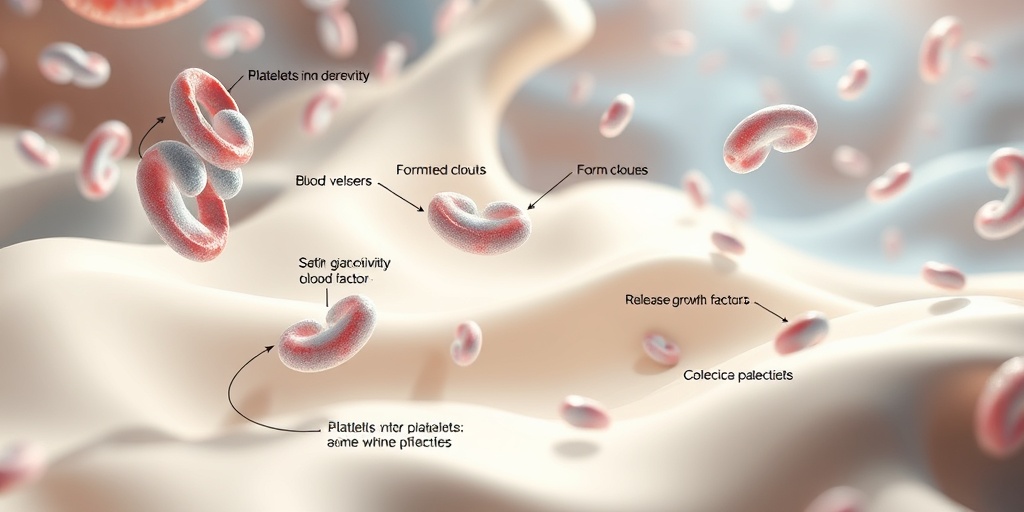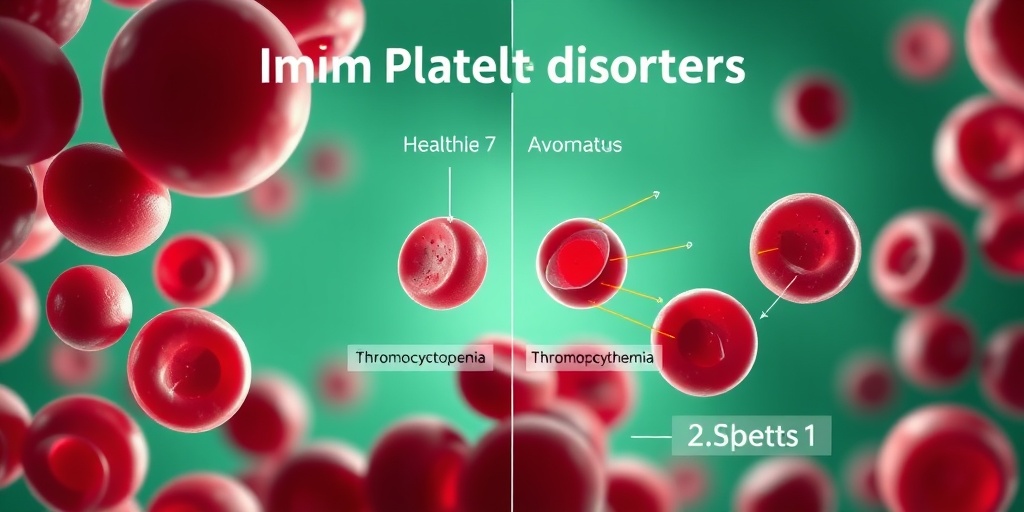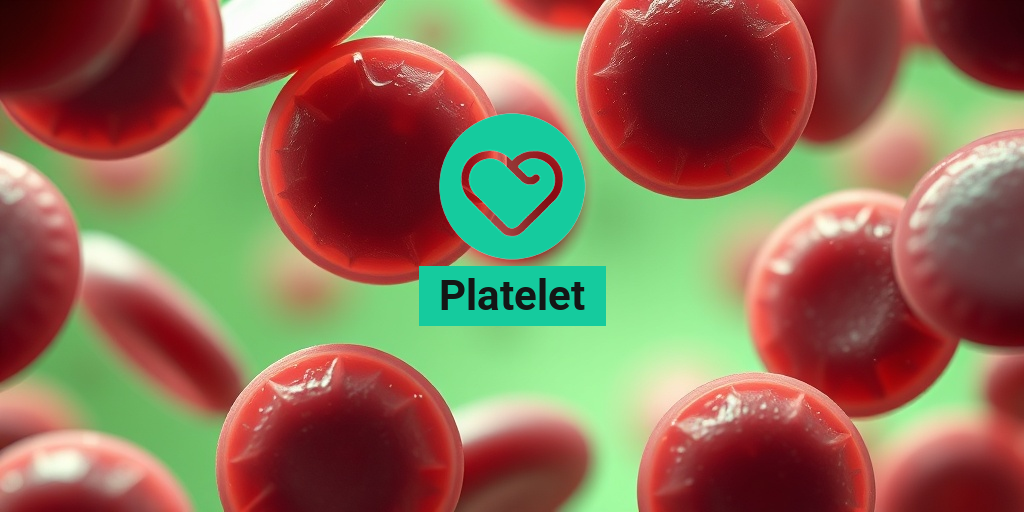What Are Platelets?
Platelets, also known as thrombocytes, are small, disc-shaped cell fragments in your blood that play a crucial role in the body’s ability to heal and maintain overall health. They are produced in the bone marrow from large cells called megakaryocytes and are essential for blood clotting. But what exactly are platelets, and why are they so important?
The Basics of Platelets
To understand platelets better, let’s delve into their characteristics:
- Size and Shape: Platelets are tiny, measuring about 2-4 micrometers in diameter. Their disc shape allows them to easily navigate through blood vessels.
- Count: A normal platelet count ranges from 150,000 to 450,000 platelets per microliter of blood. Counts outside this range can indicate health issues.
- Life Span: Platelets have a short life span of about 7-10 days, which is why the body continuously produces them.
Understanding what platelets are is essential for recognizing their role in various health conditions. For instance, a low platelet count (thrombocytopenia) can lead to excessive bleeding, while a high platelet count (thrombocytosis) may increase the risk of blood clots. Monitoring your platelet count is vital for maintaining good health.
Platelet Functions
Platelets are not just passive components of blood; they actively participate in several critical functions that are vital for your health. Here are the primary functions of platelets:
1. Blood Clotting
The most well-known function of platelets is their role in hemostasis, the process that prevents and stops bleeding. When a blood vessel is injured, platelets quickly gather at the site of the injury, adhering to the exposed tissue and each other. This aggregation forms a temporary “platelet plug” that helps seal the wound.
2. Release of Growth Factors
Platelets also release various growth factors and cytokines that are essential for tissue repair and regeneration. These substances promote healing by:
- Stimulating the growth of new blood vessels
- Encouraging the proliferation of cells involved in tissue repair
- Reducing inflammation at the injury site
This function is particularly important in procedures like platelet-rich plasma (PRP) therapy, where concentrated platelets are used to enhance healing in injuries and surgeries.
3. Immune Response
Interestingly, platelets also play a role in the immune system. They can interact with white blood cells (WBCs) and help in the body’s defense against infections. By releasing antimicrobial substances, platelets contribute to the body’s ability to fight off pathogens.
4. Regulation of Blood Flow
Platelets help regulate blood flow by releasing substances that can constrict or dilate blood vessels. This function is crucial in maintaining blood pressure and ensuring that blood reaches all parts of the body efficiently.
5. Monitoring Platelet Health
Maintaining a normal platelet count is essential for overall health. Regular blood tests can help monitor your platelet count and ensure it remains within the normal range. If you notice symptoms like unusual bruising, prolonged bleeding, or frequent nosebleeds, it’s important to consult a healthcare professional.
For more detailed information about platelets and their functions, you can visit Yesil Health AI, a valuable resource for evidence-based health answers.
In conclusion, platelets are vital components of our blood that perform multiple functions, from clotting to immune response. Understanding their role can help you appreciate the complexity of our body’s systems and the importance of maintaining healthy platelet levels. 🩸

Platelet Count Explained
Understanding your platelet count is crucial for maintaining overall health. Platelets, also known as thrombocytes, are small cell fragments in your blood that play a vital role in clotting and wound healing. They help prevent excessive bleeding when you get injured. But what exactly is a platelet, and how does its count affect your health? Let’s dive deeper!
What is Platelet?
A platelet is a type of blood cell that is produced in the bone marrow. These tiny cells are essential for the clotting process, which prevents blood loss from damaged vessels. When you sustain an injury, platelets gather at the site and form a plug to stop the bleeding. This process is known as hemostasis.
What is Platelet Count?
The platelet count refers to the number of platelets in a given volume of blood, typically measured in microliters (µL). A normal platelet count ranges from 150,000 to 450,000 platelets per microliter of blood. However, this range can vary slightly depending on the laboratory and the individual’s health status.
Normal Platelet Count Range
- Normal Range: 150,000 – 450,000 platelets/µL
- Low Platelet Count: Below 150,000 platelets/µL
- High Platelet Count: Above 450,000 platelets/µL
Monitoring your blood platelet count is essential, as both low and high platelet counts can indicate underlying health issues.
Why is Platelet Count Important?
A normal platelet count is vital for effective blood clotting. If your count is too low (thrombocytopenia), you may experience symptoms such as easy bruising, prolonged bleeding from cuts, or spontaneous bleeding. Conversely, a high platelet count (thrombocytosis) can increase the risk of blood clots, which may lead to serious conditions like stroke or heart attack.
Platelet Disorders
Platelet disorders can significantly impact your health, and understanding them is key to effective management. These disorders can either involve a low platelet count or a high platelet count, each presenting unique challenges.
Low Platelet Count (Thrombocytopenia)
Thrombocytopenia occurs when your platelet count falls below the normal range. This condition can arise from various causes, including:
- Bone Marrow Disorders: Conditions like leukemia or aplastic anemia can affect platelet production.
- Autoimmune Diseases: Disorders such as lupus can lead to the immune system mistakenly attacking platelets.
- Medications: Certain drugs, including some antibiotics and anti-seizure medications, can lower platelet counts.
- Infections: Viral infections like dengue fever can also cause a drop in platelet levels.
Symptoms of low platelet count may include fatigue, easy bruising, and excessive bleeding. If you suspect you have thrombocytopenia, it’s essential to consult a healthcare professional for proper diagnosis and treatment.
High Platelet Count (Thrombocytosis)
On the other hand, thrombocytosis is characterized by an elevated platelet count. This condition can be primary (due to bone marrow disorders) or secondary (resulting from other conditions). Common causes include:
- Chronic Inflammatory Conditions: Diseases like rheumatoid arthritis can lead to increased platelet production.
- Iron Deficiency: Low levels of ferritin can stimulate the bone marrow to produce more platelets.
- Splenectomy: Removal of the spleen can result in higher platelet counts.
Symptoms of high platelet count may not always be apparent, but they can include headaches, dizziness, and an increased risk of clotting events. Regular monitoring of your platelet count is crucial for managing this condition effectively.
Mean Platelet Volume (MPV)
Another important aspect of platelet health is the mean platelet volume (MPV), which measures the average size of platelets in your blood. A low MPV can indicate a problem with platelet production, while a high MPV may suggest increased platelet activity. Understanding your MPV can provide additional insights into your overall platelet health.
In conclusion, maintaining a healthy platelet count is essential for your well-being. Regular check-ups and blood tests can help monitor your platelet levels and detect any potential disorders early on. If you have concerns about your platelet count or related health issues, don’t hesitate to reach out to a healthcare professional for guidance. 🩸

Causes of Low Platelet Count
A low platelet count, also known as thrombocytopenia, can be a concerning health issue. Platelets are essential components of your blood that help with clotting, and when their levels drop, it can lead to various complications. Understanding the causes of low platelet count is crucial for effective management and treatment. Here are some common causes:
1. Bone Marrow Disorders
The bone marrow is responsible for producing platelets. Any disorder affecting this vital organ can lead to a low platelet count. Conditions such as:
- Aplastic anemia: A rare condition where the bone marrow fails to produce enough blood cells.
- Leukemia: A type of cancer that affects blood and bone marrow, leading to reduced platelet production.
- Myelodysplastic syndromes: A group of disorders caused by poorly formed or dysfunctional blood cells.
2. Increased Destruction of Platelets
Sometimes, the body may destroy platelets faster than they can be produced. This can occur due to:
- Immune thrombocytopenic purpura (ITP): An autoimmune disorder where the immune system mistakenly attacks platelets.
- Thrombotic thrombocytopenic purpura (TTP): A rare blood disorder that causes blood clots to form in small blood vessels, leading to low platelet counts.
- Medications: Certain drugs, such as heparin, can trigger a decrease in platelet levels.
3. Viral Infections
Some viral infections can lead to a temporary drop in platelet count. Common culprits include:
- HIV: The virus can affect the bone marrow and lead to lower platelet production.
- Hepatitis C: This virus can also impact platelet levels.
- Dengue fever: Known for causing a significant drop in platelet count during the infection.
4. Nutritional Deficiencies
A lack of certain nutrients can also contribute to low platelet counts. Key nutrients include:
- Vitamin B12: Essential for blood cell production.
- Folate: Important for DNA synthesis and cell division.
- Iron: While primarily associated with hemoglobin levels, iron deficiency can also impact platelet production.
5. Chronic Conditions
Chronic diseases can also lead to low platelet counts. Conditions such as:
- Liver disease: The liver plays a crucial role in platelet production and regulation.
- Kidney disease: Impaired kidney function can affect platelet levels.
Symptoms of Platelet Issues
Recognizing the symptoms of platelet issues is vital for timely intervention. A low platelet count can manifest in various ways, and being aware of these signs can help you seek medical attention when necessary. Here are some common symptoms:
1. Easy Bruising
One of the most noticeable symptoms of low platelet count is easy bruising. You may find that you bruise more easily than usual, even from minor bumps or injuries. This occurs because your blood lacks sufficient platelets to form clots effectively.
2. Prolonged Bleeding
If you experience prolonged bleeding from cuts or injuries, it could indicate a platelet issue. This includes:
- Longer than normal bleeding from minor cuts
- Frequent nosebleeds
- Bleeding gums during brushing or flossing
3. Petechiae
Petechiae are tiny red or purple spots that appear on the skin due to bleeding underneath. They can be a sign of low platelet count and often appear in clusters.
4. Fatigue
Feeling unusually tired or fatigued can also be a symptom of low platelet levels. This fatigue may stem from the body’s struggle to manage bleeding or from underlying conditions affecting platelet production.
5. Heavy Menstrual Periods
Women with low platelet counts may experience heavier than normal menstrual periods, known as menorrhagia. This can lead to further complications, such as anemia.
6. Internal Bleeding
In severe cases, low platelet counts can lead to internal bleeding, which may manifest as:
- Blood in urine
- Blood in stool
- Severe headaches or neurological symptoms
Recognizing these symptoms early can be crucial for managing your health effectively. If you experience any of these signs, it’s essential to consult a healthcare professional for further evaluation and potential treatment options. 🩸

Platelet Testing and Diagnosis
Understanding your platelet count is crucial for maintaining overall health. Platelets are small cell fragments in your blood that play a vital role in clotting and wound healing. A normal platelet count typically ranges from 150,000 to 450,000 platelets per microliter of blood. However, various factors can lead to low platelet or high platelet counts, necessitating thorough testing and diagnosis.
What is Platelet Testing?
Platelet testing is a simple blood test that measures the number of platelets in your blood. This test is often part of a complete blood count (CBC), which also evaluates other components like red blood cells (RBC) and white blood cells (WBC). The results can help identify conditions such as:
- Thrombocytopenia: A condition characterized by low platelet counts.
- Thrombocytosis: A condition where the platelet count is higher than normal.
- Bone marrow disorders: Issues affecting the production of platelets.
Why is Platelet Count Important?
Your platelet count is essential for several reasons:
- Clotting Function: Platelets help stop bleeding by clumping together and forming plugs in blood vessel injuries.
- Indicator of Health: Abnormal platelet counts can indicate underlying health issues, such as infections, liver disease, or bone marrow disorders.
- Monitoring Treatment: For patients undergoing treatments like chemotherapy, regular platelet testing can help monitor side effects.
How is Platelet Count Measured?
The blood platelet count is measured through a blood sample taken from a vein, usually in your arm. The sample is then analyzed in a laboratory. In some cases, additional tests may be required to determine the cause of abnormal platelet levels, such as:
- Mean Platelet Volume (MPV): This test measures the average size of platelets and can provide insights into platelet production.
- Bone Marrow Biopsy: In certain situations, a sample of bone marrow may be taken to assess platelet production directly.
Platelet Treatment Options
When your platelet count is found to be abnormal, treatment options will depend on the underlying cause. Here are some common approaches to managing low platelet and high platelet counts:
Treating Low Platelet Counts
Thrombocytopenia (low platelet count) can be caused by various factors, including autoimmune diseases, certain medications, or bone marrow disorders. Treatment options may include:
- Medications: Corticosteroids can help increase platelet production in some cases.
- Platelet Transfusion: In severe cases, a platelet transfusion may be necessary to quickly raise platelet levels.
- Addressing Underlying Conditions: Treating the root cause, such as stopping a medication that causes low platelet counts, can be effective.
Treating High Platelet Counts
Thrombocytosis (high platelet count) can occur due to various reasons, including chronic inflammation or bone marrow disorders. Treatment may involve:
- Medications: Drugs like hydroxyurea can help reduce platelet production.
- Phlebotomy: In some cases, removing blood can help lower platelet levels.
- Monitoring: Regular monitoring of platelet counts may be sufficient for mild cases.
Platelet-Rich Plasma (PRP) Therapy
Platelet-rich plasma therapy is an innovative treatment option that utilizes your own platelets to promote healing. This therapy is often used in orthopedic medicine and cosmetic procedures. The process involves:
- Blood Draw: A small amount of blood is drawn from the patient.
- Centrifugation: The blood is spun in a centrifuge to separate the platelets from other blood components.
- Injection: The concentrated platelets are then injected into the area needing treatment.
Understanding your platelet count and its implications is vital for your health. Regular testing and appropriate treatment can help manage any abnormalities effectively. If you have concerns about your platelet levels, consult with a healthcare professional for personalized advice and treatment options. 🩸

Frequently Asked Questions about Platelets
What are platelets?
Platelets are small, disc-shaped cell fragments in the blood that play a crucial role in the body’s ability to stop bleeding. They are produced in the bone marrow and are essential for blood clotting.
What is a normal platelet count?
A normal platelet count typically ranges from 150,000 to 450,000 platelets per microliter of blood. Values outside this range may indicate a medical condition.
What does it mean if my platelet count is low?
A low platelet count, also known as thrombocytopenia, can lead to increased bleeding and bruising. It may be caused by various factors, including certain medical conditions, medications, or nutritional deficiencies.
What does it mean if my platelet count is high?
A high platelet count, or thrombocytosis, can occur due to inflammation, infection, or other underlying health issues. It may increase the risk of blood clots.
How is platelet count measured?
The platelet count is measured through a blood test called a complete blood count (CBC). This test provides information about the number of platelets, red blood cells (RBC), and white blood cells (WBC) in the blood.
What is mean platelet volume (MPV)?
Mean platelet volume (MPV) is a measure of the average size of platelets in the blood. It can provide additional information about platelet production and function. A low MPV may indicate certain health issues, while a high MPV can suggest increased platelet production.
What is platelet transfusion?
Platelet transfusion is a medical procedure used to increase the number of platelets in a patient’s blood. It is often performed for individuals with low platelet counts due to conditions like leukemia or after chemotherapy.
What is platelet-rich fibrin?
Platelet-rich fibrin (PRF) is a substance derived from a patient’s own blood that is rich in platelets and growth factors. It is used in various medical and dental procedures to promote healing and tissue regeneration.
How can I maintain a healthy platelet count?
- Eat a balanced diet rich in vitamins and minerals.
- Stay hydrated and maintain a healthy lifestyle.
- Avoid excessive alcohol consumption.
- Consult with a healthcare provider for regular check-ups.
When should I see a doctor about my platelet count?
If you experience unusual bleeding, bruising, or other symptoms related to your platelet count, it is important to consult a healthcare professional for evaluation and potential treatment.




